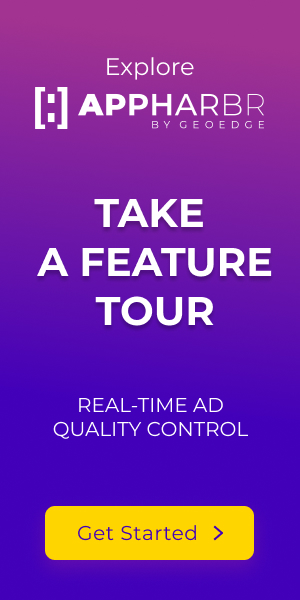Misleading product offer ads are a threat to publishers’ revenue streams and brand integrity. Mobile game studios and app developers are frequently targeted by deceptive ad creatives and subtle, misleading tactics that erode user engagement and trust. AppHarbr is the only dedicated real-time solution built to block misleading product offers. Other ad management tools do not have the advanced automated ability to block mobile malvertising in real time. Born from GeoEdge, AppHarbr has mastered the ability to detect and block malvertising from reaching your users, helping you safeguard your revenue and reputation. In this deep dive, we’ll identify concrete, misleading mobile advertisements, pinpoint red flags for deceptive mobile creatives, and provide proven detection tools and ad-quality solutions to help publishers maintain rigorous control and ad quality standards.
Common Misleading Mobile Product Offer Ads Examples in Apps & Games
Misleading mobile product offers are continually evolving, becoming sophisticated enough to evade standard detection mechanisms and damage publisher reputations. The basic structure of misleading product offer ads is an enticing, often too-good-to-be-true product that tricks users into paying for a product they never receive.
Common examples include:
- Weight loss pills
- Anti-aging treatments
- Health supplements
- Mobile game advancements, such as additional plays
- Technology product offerings
They mislead consumers, prompting churn and negative reviews. When customers learn that your app contains misleading advertising that takes their money, they are likely to leave a bad review, damaging your business’s reputation and costing you revenue.


Misleading ads also impact user trust for the app, as the credibility of the ads reflects on the app itself. For example, subscription-trap ads deceptively enroll unwitting users into premium services without clear disclosures, resulting in backlash, app store penalties, and even regulatory attention. Other scams include false promises such as bold health claims, cosmetic benefits, luring consumers into paying for something that doesn’t exist.
Understanding these common deceptive tactics empowers publishers and ad mon professionals to preemptively identify problematic creatives, protecting brand credibility and key revenue metrics. By analyzing and sharing precise examples internally, publishers create stronger immunity to future deceptive campaigns jeopardizing both user trust and monetization performance.
How Misleading Ads Infiltrate the Programmatic Supply Chain
Misleading ad creatives typically infiltrate the programmatic supply chain via Demand Side Platforms (DSPs), where initial creative approvals can be circumvented through strategic misrepresentations. A misleading product scam usually starts with the scammers pretending to be legitimate advertisers and buying media for a legitimate campaign. Here is where scammers gain the trust of ad networks and DSPs, granting them approval through initially showing harmless ads and landing pages. Because DSPs do not have the robust capabilities to block clickbait, misleading product offer scams continue through the pipeline. Once approved, these deceptive ads rotate creative IDs, cloak originating domains, and blend into the real-time bidding (RTB) stream, falsely presenting as legitimate inventory. Without precise visibility and granular, SDK-level controls, publishers remain blind to subtle variations and mutations in deceptive creative behavior, ultimately allowing misleading ads to silently enter and persist within their mobile app ecosystems, eroding user trust and revenue alike.
Misleading product offers work similarly to financial scam ads. They combine several fraudulent elements to lure users into buying a product with false claims while trying to avoid being detected by ad security vendors. This makes them very effective and very popular. They are also both so common because of their ability to be altered just enough to bypass detection, even after a previous version of the creative was flagged.
Spotting Deceptive Mobile Ad Creatives: Red Flags and Examples
Manually identifying deceptive advertisements requires a practiced eye and clearly defined red flags. Industry veterans understand that detection goes beyond surface-level advertising; it’s about recognizing intent, tactics, and subtle UX manipulations. Common deceptive practices include exaggerated promises (e.g., “Win real cash instantly!”), false countdown timers that create an illusion of urgency, and intentionally vague subscription disclosures hidden in microscopic fonts or hard-to-see color contrasts. The corresponding landing pages usually pretend to be blogs discussing health, fashion, or entertainment information. They display a misleading or fake article to make the story in the ad creative seem legitimate, promoting an offer that is too good to be true or a service with no real company or vendor behind it. They’re often enhanced with fake comments and reviews to make the scam seem more legitimate
The landing pages are usually designed so that any clickable element on them leads users to an offer page urging them to buy the product or register for the service. Cases frequently observed by ad-quality teams include banner ads leveraging fake app update alerts, mimicking system notifications, or falsely claiming malware infection to drive panicked clicks and installs. Experienced programmatic professionals instantly pinpoint out-of-context gameplay footage or improbable lifestyle claims as indicators of a deceptive creative. Deploying systematic creative review processes—such as creative fingerprinting, image hash matching, and behavioral heuristics—makes these misleading advertisements significantly easier to identify and eliminate at scale.
Why Traditional Creative QA Fails
Misleading product offer ads flow through the same pipes as legitimate demand, but they exploit key gaps in the process. Ad scammers mutate creatives subtly and exploit the limitations of standard DSP filters.
Manual review pitfalls include:
- Inability to keep pace with creative volume
- Human bias and error in subjective judgment
- Delayed resolution cycles
- Poor reporting trails and accountability gaps
How to Recognize and Identify Misleading Products Offer Ads
Industry veterans may have strong detection abilities, but relying on a highly trained eye manually monitoring misleading advertising is not a sufficient strategy. Since demand-side platforms are not robust enough to block this kind of fraudulent advertising, detection and identification of misleading ads in mobile games is essential for operational effectiveness and revenue protection. Ad monetization teams must move beyond manual reviews into systematic, scalable detection solutions informed by clearly defined criteria. Automated detection models like AppHarbr are powered by machine learning algorithms trained on extensive misleading ad datasets. This increases the efficacy of flagging irregular patterns or behavioral anomalies indicative of deception, scaling back the manual efforts previously required by developers.

To avoid being detected by mediation systems that combat malvertising, misleading product offers may employ a cloaking mechanism that enables them to cherry-pick users to scam, based on parameters such as device type, internet connection, location, and more. When cloaking kicks in, users are redirected to an innocent landing page that may or may not have any connection to the ad or the scam landing page, and may not even have a call to action. The cloaking mechanism enables scammers to stay hidden and strike only when and where they choose.
Detecting and Eliminating Misleading Mobile Ad Networks: Proven Approaches
Identifying and mitigating deceptive ad practices at the network level has an outsized impact, and industry veterans recognize its importance. Misleading mobile ad networks often operate by obfuscating their source domains, rotating fraudulent creative IDs, and rapidly cycling through multiple insertion points to avoid detection. So, while you may have caught a misleading ad campaign in the past, the same scam is repeatedly altered slightly to strike repeatedly, bypassing your detection.
Ad quality professionals need granular, rigorous detection tools that identify patterns of deceptive activity. Employing AppHarbr’s detection and blocking mechanisms ensures that developers can address the issue to scale while eliminating manual efforts. Implementing dynamic real-time blocking allows publishers to automatically flag and remove traffic from fraudulent or misleading networks and scammers, significantly boosting LTV and revenue potential.
Best Practices to Prevent Misleading Mobile Product Offers from Impacting Your App
Proactively safeguarding your apps from misleading advertising requires clearly defined best practices implemented across operational layers. Explicitly defining deceptive practices, prohibited ad behaviors, and enforcement consequences are the first steps to combating the pervasive issue and protecting against financial losses.
Publishers should consistently monitor demand source performance and ad quality violations to minimize risk exposure. The key to successful elimination of this deceptive advertising is implementing an automated, dynamic in-app ad review process that swiftly uncovers problematic ad experiences before they reach users. In addition to stopping misleading offer scam ads from being served, an automated solution like AppHarbr will inform you of the blocked creative, sending a report to your team and to the platform it came from. This cuts down significantly on time, guesswork, and back-and-forth trying to reactively address issues one by one. Programmatic leaders increasingly rely on automated flags and threshold alerts triggered by spikes in user complaints, bounce rates, or CTR anomalies—clear indicators signaling emerging misleading ad campaigns. Integrating proactive ad quality practices safeguards publisher revenue stability and brand trust.
Robust Solutions and Software to Manage and Block Misleading Mobile Product Offers
Combating misleading ads at scale requires specialized solutions tailored for advanced ad quality management. Professional ad quality teams increasingly rely on robust platforms capable of real-time scanning, granular creative assessment, and automated response workflows to rapidly identify and remove misleading ads. Solutions leverage sophisticated techniques such as creative fingerprinting, text analysis, behavioral heuristics, and ML-based anomaly detection. Publishers benefit from actionable dashboards with detailed violation reports, streamlined block list management capabilities, and automated policy enforcement workflows. Ultimately, adopting purpose-built, ad-blocking software provides unparalleled visibility and control, dramatically reducing exposure to misleading product offers and monetization risks.
Industry-Leading Tools and Platforms for Detecting Misleading Mobile Advertisements
Accurately detecting misleading mobile ads demands specialized tooling designed specifically for mobile ecosystems. AppHarbr, an industry-leading platform, combines AI, machine-learning algorithms, and robust real-time monitoring to proactively isolate deceptive ad campaigns. Tools powered by creative fingerprinting and computer vision technologies rapidly identify recycled deceptive ads, even after slight creative modifications. Additionally, data platforms leverage traffic anomaly detection and performance benchmarking to uncover previously unnoticed patterns indicative of deception. Real-time alerts and collaborative workflow features facilitate streamlined communication across monetization, compliance, and operations teams. Leveraging powerful detection tools translates directly to reduced risk, greater revenue predictability, and fortified brand credibility.
A Proactive Defense Against Misleading Mobile Product Offers
Misleading mobile ads represent a persistent threat that undermines monetization goals, operational efficiency, and brand reputation. Publishers who proactively implement robust detection frameworks, enforce stringent network blacklisting protocols, and deploy specialized ad-quality software gain a critical competitive advantage. By recognizing common misleading advertising quickly, publishers can markedly reduce exposure to problematic ads and safeguard revenue streams while strengthening user trust and business stability.
Ready to strengthen your mobile ad quality strategy? Discover how AppHarbr empowers publishers to identify, prevent, and eliminate misleading mobile ads effectively—get started today.




